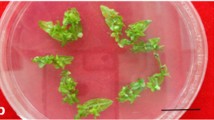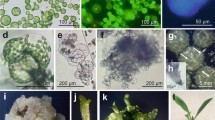Abstract
Cells and protoplasts isolated from three different tissues of sunflower hypocotyls and cultured either in liquid or agarose medium were compared in terms of their volume, DNA content, division potential and embryoid formation. Epidermal and external cortical cells differ from other tissue cells by their small size, their weak response to plasmolysis and their low DNA content (around 1C). They contribute only very weakly to the dividing protoplast population. In contrast, protoplasts from cortical and medullar cells both have similar division potential, reaching 50%. The nuclear DNA content of these two cell types, as well as their corresponding protoplasts, has a 2C value, taking root tip cells in G0 phase as standard. The culture conditions induce the same specific response in protoplasts isolated from both tissues: exclusively loose colony formation in liquid medium, and mainly production of embryoids in agarose medium.
Similar content being viewed by others
References
Alibert G, Aslane-Chanabé C & Burrus M (1994) Sunflower tissue and cell cultures and their use in biotechnology. Plant Physiol. Biochem. 32:(1): 31–44
Berg A R, MacDonald I R, Hart J W & Gordon D C (1986) Relative elemental elongation rates in the etiolated hypocotyl of sunflower (Helianthus annuus L.) — A comparison of straight growth and gravitropic growth. Bot. Gaz. 147: 373–382
Cavallini A & Lupi M C (1987) Cytological study of callus and regenerated plants of sunflower (Helianthus annuus L.). Plant Breed. 99: 203–208
Cavallini A, Natali L, Cionini G, Sassoli O, Cionini P G & Durante M (1992) Nuclear DNA content variations in sunflower. In 13th Int. Sunflower Conf., Vol II (pp 1432–1437). Pisa (Italy)
Chanabé C, Burrus M & Alibert G (1989) Factors affecting the improvement of colony formation from sunflower protoplasts. Plant Sci. 64: 125–132
Chanabé C, Burrus M, Bidney D & Alibert G (1991) Studies on plant regeneration from protoplasts in the genus Helianthus. Plant Cell Rep. 9: 635–638
Dijak M, Smith D L, Wilson T J & Brown D C W (1986) Stimulation of direct embryogenesis from mesophyll protoplasts of Medicago sativa. Plant Cell Rep. 5: 468–470
Emons A-M (1994) Somatic embryogenesis: cell biological aspects. Acta Bot. Neerl. 43: (1): 1–14
Fisher C & Hahne G (1992) Structural analysis of colonies derived from sunflower (Helianthus annuus L.) protoplasts cultured in liquid and semi-solid media. Protoplasma 169: 130–138
Kao KN & Michayluk M R (1980) Plant regeneration from mesophyll protoplasts of alfalfa. Z. Pflanzenphysiol. 96: 135–141
Kobayashi S, Ilceda I & Uchimiya H (1985) Conditions for high frequency embryogenesis from orange (Citrus sinensis Obs.) protoplasts. Plant Cell Tiss. Org. Cult. 4: 249–259
Levi M, Tarquini F, Sgorbati S & Sparvoli E (1986) Determination of DNA content by static fluorimetry in nuclei released from fixed plant tissues. Protoplasma 132: 64–68
Li L C & Kohlenbach H W (1982) Somatic embryogenesis in quite a direct way in cultures of mesophyll protoplasts of Brassica napus L. Plant Cell Rep. 1: 209–211
Lindsey K & Topping J F (1993) Embryogenesis: a question of pattern. J. Exp. Bot. 44: 359–374
Lorz H, Potrykus I & Thomas E (1977) Somatic embryogenesis from tobacco protoplasts. Naturwiss. 64: 439–440
Meyer Y & Abel W O (1975) Importance of the wall for cell division and in the activity of the cytoplasm in cultured tobacco protoplasts. Planta 123: 33–40
Molz F J & Boyèr J S (1978) Growth-induced water potentials in plant cells and tissues. Plant Physiol. 62: 423–429
O'Neill C M & Mathias R J (1993) Regeneration of plants from protoplasts of Arabidopsis thaliana via direct embryogenesis. J. Exp. Bot. 44 (267): 1579–1585
Potrykus I & Shillito R D (1986) Protoplasts: isolation, culture, plant regeneration. In: Weissbach A & Weissbach H (Eds) Plant Molecular Biology, Vol 118: (pp 549–578). Academic Press
Schilde-Rentschler L (1977) Role of the cell wall in the ability of tobacco protoplasts to form a callus. Planta 135: 177–181
Sgorbati S, Levi M, Sparvoli E, Trezzi F & Lucchini G (1986) Cytometry and flow cytometry of 4′,6-diamidino-2-phenylindole (DAPI)-stained suspensions of nuclei released from fresh and fixed tissues of plants. Physiol. Plant. 68: 471–476
Vasil I (1987) Developing cell and tissue culture systems for the improvement of cereal and grass crops. J. Plant. Physiol. 128: 193–218
Willison J H M (1985) Isolated protoplasts as laboratory tools in the study of cell wall deposition. In: Fowke L C & Constabel F (Eds) Plant Protoplasts (pp 77–89). CRC Press, Boca Raton
Author information
Authors and Affiliations
Rights and permissions
About this article
Cite this article
Petitprez, M., Brière, C., Borin, C. et al. Characterisation of protoplasts from hypocotyls of Helianthus annuus in relation to their tissue origin. Plant Cell Tiss Organ Cult 41, 33–40 (1995). https://doi.org/10.1007/BF00124084
Accepted:
Issue Date:
DOI: https://doi.org/10.1007/BF00124084




